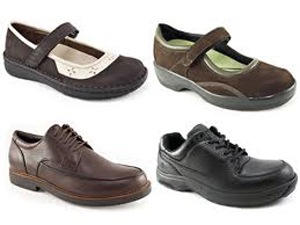
Shoes for Diabetics
When you’re diagnosed with diabetes, one of the first things your doctor will recommend you buy is a specialized pair of shoes designed specifically for a diabetic. Shoes of this nature will need to have proper ventilation, which will allow the feet to have less dampness and heat than regular shoes. Because sweat is an ideal environment for bacteria and infection to grow, you want to make sure the toe and heal curves slightly, so your feet have to be balanced when you walk. Diabetic shoes will also need to prevent injury to susceptible and sensitive toes, so the toe area will probably be high and durable. Diabetic shoes are also usually lightweight and seamless to prevent common shoe irritations such as calluses, blisters, or infection. There are several reasons why you need to wear diabetic shoes. Outlined below are a few good reasons you need to ensure one of your first purchases after your diabetic diagnosis includes diabetic shoes:
The wrong shoes can cause nerve damage. Because neuropathy can cause the loss of feeling in your feet, you’ll be unable to tell if your feet are injured. It’s easy to step onto a sharp object and not know it until you see blood.
The wrong shoes can cause poor circulation, because diabetic arteries are easily rigid and blocked. Diabetic shoes ensure that you’re not cutting off any additional circulation by using the wrong shoes.
If your vision is impaired, you’ll be unable to see small cuts and sores that can happen in normal shoes. By giving yourself the gift of diabetic shoes, you’ll actually be allowing yourself the comfort of knowing that your feet are in a safe place.
When you’re choosing the footwear of diabetic shoes, there are a number of things you need to be watchful for. First of all, shoes that do not fit properly can cause foot trauma, so make sure both your shoes and socks fit well. You also want to make sure that the shoes you buy are made from natural materials to allow for optimal circulation. Also make sure to buy your shoes in the afternoon when your feet are at their largest size, and while you’re at it make sure there’s ample ‘wiggle room’ for your toes.
While diabetic shoes may be the furthest thing from your mind when you’re diagnosed with diabetes, they will be an instrumental tool in relieving many of the aches, pains, and worries associated with the disease. Make sure it’s at the top of your purchase list to ensure that you start your treatment on the right foot!
* * * * * * * * * *
I am diabetic but also grossly overweight, and one thing I have suffered with is swollen feet and ankles, but this could vary quite a bit during the day, and I found that shoes that fastened with Velcro, or where softly elasticated really did help me. It is always necessary to make sure whatever type of shoe or trainer you get, are a good fit, because any tightness will cause you a problem. One thing I have found is that now I am into walking and weight loss, swollen feet and ankles are almost a thing of the past, except on really hot days, and surprisingly I didn’t need to lose that much weight for it to take effect. If you are looking towards a trainer type of shoe, check out the Merrell range of footwear, I have found them to be so light and comfortable you don’t realize you are wearing them.